Range Rover Evoque: Rear Side Member Upper Side Extension
Removal
NOTES:
The rear side member upper side extension is manufactured from mild steel.
If a new Rear side member upper side extension is being replaced in combination with a rear side member closing panel some MIG plug welds can be substituted for spot welds on installation within this procedure.
If the rear side member upper extension panel is being reinstalled from the procedure of the rear side member, the removed spot weld locations must be MIG plugged on reinstallation.
1. The rear side member upper side extension is replaced in conjunction with:
- Rear bumper cover
- Rear bumper
- Rear lamp mounting panel
- Back panel
- Rear bumper mounting
- Inner back panel assembly
- Rear side member lower side extension
2. For additional information relating to this repair procedure please see the following: For additional information, refer to: Health and Safety Precautions (100-00 General Information, Description and Operation) / Body Repairs (501-25A Body Repairs - General Information, Description and Operation) / Corrosion Protection (501-25B Body Repairs - Corrosion Protection, Description and Operation) / Body and Frame (501-26 Body Repairs - Vehicle Specific Information and Tolerance Checks, Description and Operation) / Standard Workshop Practices (100-00 General Information, Description and Operation).
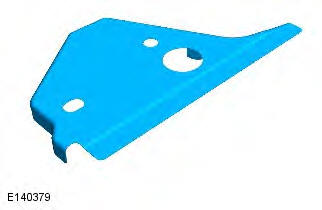
3. Remove the rear side member lower side extension.
For additional information, refer to: Rear Side Member Lower Side Extension (501-30B Rear End Sheet Metal Repairs - 5-Door, Removal and Installation).
4. Remove the inner back panel assembly.
For additional information, refer to: Inner Back Panel Assembly (501-30B Rear End Sheet Metal Repairs - 5-Door, Removal and Installation).
5. NOTE: RH side only. Remove fuel filler neck.
For additional information, refer to: Fuel Tank Filler Pipe (310-01A Fuel Tank and Lines - TD4 2.2L Diesel, Removal and Installation).
6. LH only. Release and lay aside differential breather pipes.
7. Drill out the spot welds as indicated.
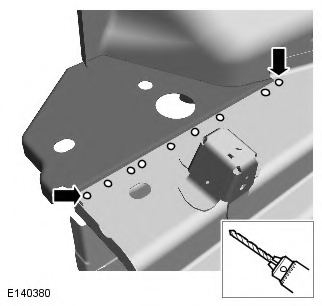
8. Drill out spot welds as indicated.
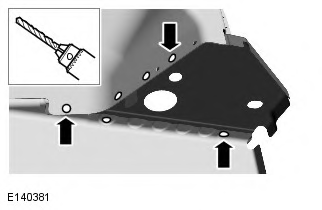
9. Separate the joints and remove the old panel.
Installation
1. NOTE: MIG plug welded joints that have cured adhesive in them must be cleaned out as well as possible with the access available. Prepare the panel joint surfaces of the old and new rear side member upper side extension.
2. Offer up the new panel and clamp into position. Check alignment, if correct, proceed to next step, if not, rectify and recheck before proceeding.
3. NOTES:
If the rear side member closing panel is being replaced this joint can be spot welded on installation.
Drill MIG plug locations through new panel taking care not to drill into rear side member. While the new panel is clamped in position drill out MIG plug locations as indicated.
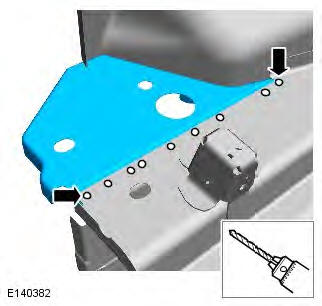
4. Remove the new panel.
5. Deburr MIG plug locations in new panel.
6. Offer up the new panel and clamp into position. Check alignment, if correct, proceed to next step, if not, rectify and recheck before proceeding.
7. MIG plug weld as indicated.
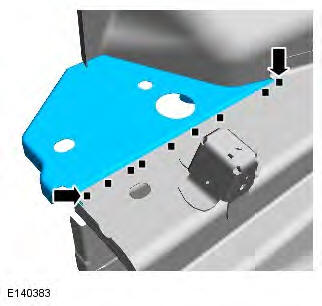
8. MIG plug weld as indicated.
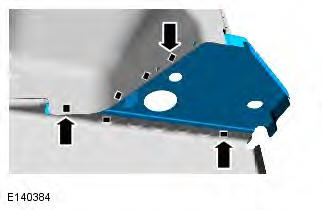
9. Dress the MIG plug welds.
10. Apply a zinc rich primer to any bare metal surfaces at this stage.
11. NOTE: Make sure all underbody joints are sealed following this repair procedure
The installation of associated panels and mechanical components is the reverse of removal.
Rear End Sheet Metal
Rear end service panels
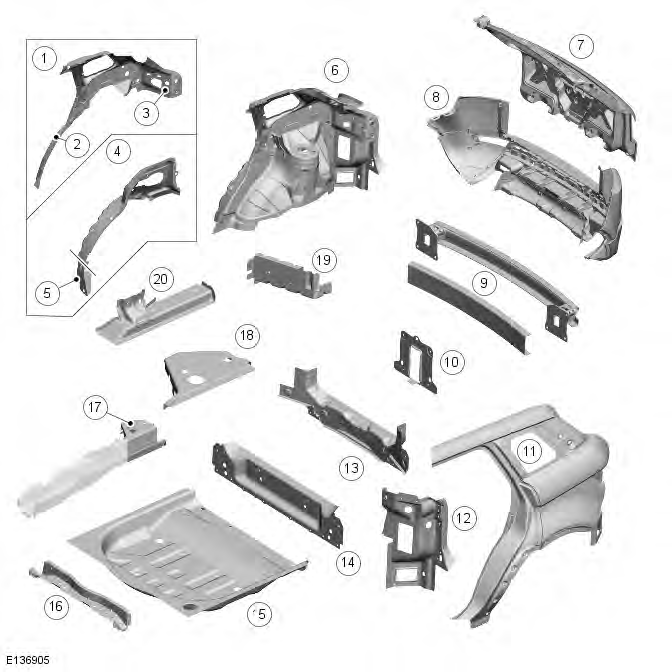
- Inner quarter panel
- Inner quarter panel front
- Inner quarter panel rear
- Rear wheelhouse outer
- Rear wheelhouse front extension
- Inner quarter panel and wheelhouse
- Liftgate
- Rear bumper cover
- Rear bumper and stiffener
- Rear bumper mounting
- Quarter panel
- Rear lamp mounting panel
- Back panel assembly
- Back panel
- Spare wheel well
- Rear crossmember
- Rear side member section
- Rear side member upper side extension
- Rear side member lower side extension
- Rear side member closing panel
Galvanic Corrosion
For additional information, refer to: Corrosion Protection (501-25B Body Repairs - Corrosion Protection, Description and Operation).
Time schedules, rear end
The following schedules show the total time taken to replace single panels and also combinations of panels. The published times include the removal of Mechanical, Electrical and Trim, (MET), items, plus paint times based on Metallic Clear Over Base Paint, (blends to adjacent panels are not included). A corrosion protection time is included where appropriate.
The times were generated by Thatcham, (the Motor Insurance Repair Research Centre), and are to be used as a guide only, based on new undamaged panels. Job allowances are not included, as a guide Thatcham recommend 0.3 hours to be added to single panel times and 0.5 hours to be added to combination times.
Single panel times

Combination panel replacement times
Combination panel times

Combination panel times

Combination panel times
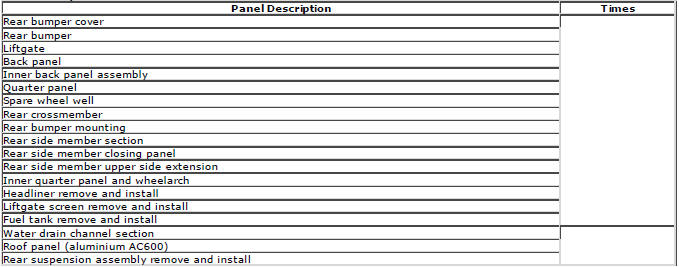

Combination panel times
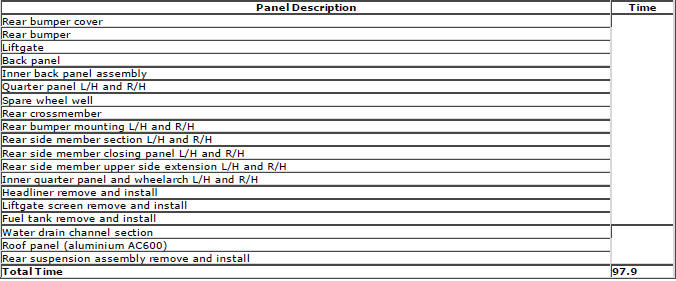
Combination panel times

Combination panel times


